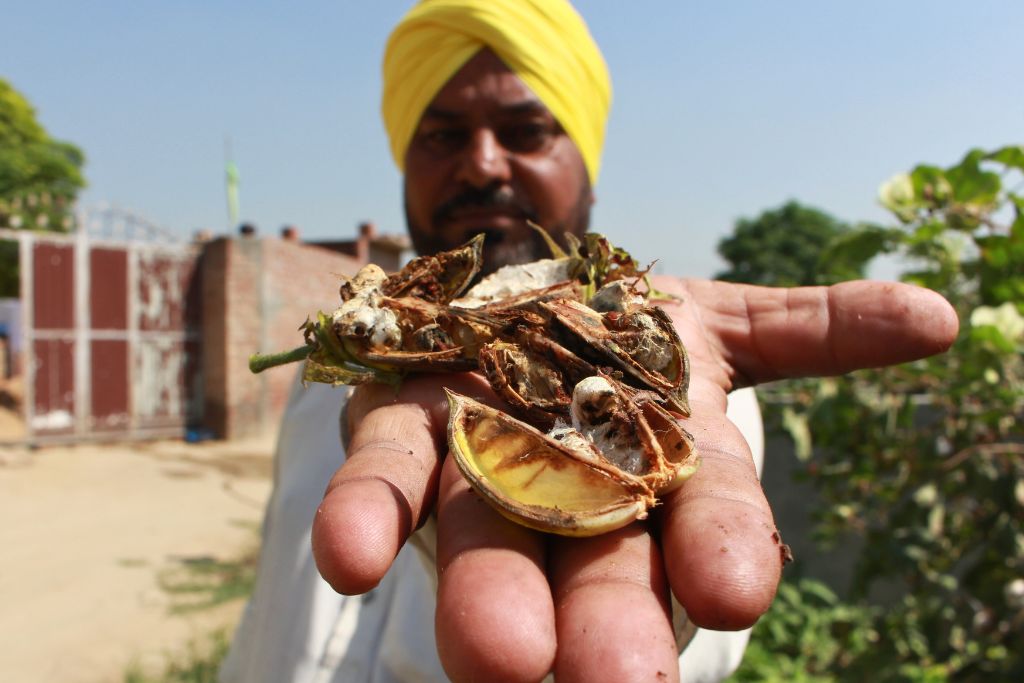
Bt cotton, pink bollworm and the debt cycle in Punjab
As cotton harvesting begins in Punjab, this World Cotton Day we look at the impact of introduction of Bt cotton in the state. Almost two decades later, farmers are still grappling with pests and other problems.
Cotton is farmed on about 3 lakh hectares in the Bathinda and Mansa districts of Punjab, which comprise around 25-26 percent of the state area. And unlike Telangana, Gujarat and Maharashtra where cotton is sown in July and August and harvested from October to March, in Punjab the kharif crop is sown in April-May and harvested around October.
Also Read: Punjab’s daughters revive its cotton weaving tradition
Bt cotton (Bacillus thuringiensis), the genetically modified cotton seed that has inbuilt resistance to fight pests like the bollworms, was introduced in India in the early 2000s. The cotton crop was plagued by the infestation, particularly by the American bollworm, in the past. A patent of the American seed biotech multinational Monsanto, Bt cotton (its variants Bt-I and Bt-II) took over the Indian market in a short time. But soon after that, the issues of pink bollworm started surfacing as the insect developed resistance to the genetically modified cotton seed.
Bt cotton was introduced to counter the problems of pest attacks on the crop and reduce the cost of insecticide and pesticide application for farmers. The instances of pink bollworm attack have been prevalent in Maharashtra, Gujarat and Telangana for many years, usually attributed to the fact that the crop is harvested during winter in these regions when the worm thrives. But Punjab faced a large-scale devastation of the crop in 2021 despite the fact it’s harvested before winter sets in here.
Also Read: Farmers go green by growing organic cotton
The pink bollworm, which is a monophagous pest, is native to the subcontinent but has now spread all over the world. The female moth lays eggs on the plant, and after hatching, the larva penetrates into the boll or the cotton flower. The larva enters the developing bolls through the tip portion which closes as the boll matures. The worm then feeds on the seed, thus damaging the Bt cotton crop from within while the farmer remains unaware of the damage.
Also Read: Weaving a tapestry on traditional looms
“The pink bollworm survives in two life cycles,” said Dr Vijay Kumar, Principal Entomologist at Punjab Agricultural University (PAU). “One is the short life cycle that starts with the sowing of Bt cotton crops in May and goes on until November, and the other is the long cycle which is during winter when the pest hibernates.” The insect survives in bales lying at homes or ginning mills or in dried cotton crop sticks that people often stack at homes for fuelwood. If the boll is not opened then the chances of its survival are more. The pest then resurfaces as the sowing season begins.
Also Read: Bengal’s weavers revive muslin, spin success
There are three main bollworms that attack the cotton crop – the pink bollworm, the American bollworm and the Egyptian or the spotted bollworm. “While the pink bollworm has developed resistance against the Bt cotton seed, the others have so far failed to do so. In that way, Bt cotton is at least keeping away the other two pests,” said Kumar.
Cotton (called narma locally) is usually cultivated by small-scale farmers. They usually take a piece of land on lease from other farmers to grow cotton, and incur further cost on the application of pesticides. This often forces them to take loans. If the crop gets damaged they find themselves trapped in a debt cycle and often resort to suicides. “In Punjab more cotton farmers died by suicide than those who grow other crops,” said Sukhpal Singh, former principal economist of Punjab Agriculture University.
In a joint study conducted by three universities in the state – Punjab Agricultural University, Ludhiana; Punjabi University, Patiala; and Guru Nanak Dev University, Amritsar, the total number of farmers and labourers who died by suicide in the state between January 2000 and December 2016 was a staggering 16,606.
“Cotton is a tricky crop when compared to paddy or wheat. Both, its production and marketing, is risky. It’s prone to many infestations and until recently, there was no minimum support price for cotton. Not just in Punjab, it’s the cotton farmers that are mostly poor in other states too,” said Sukhpal Singh.
The first sign of bollworm infestation is a rosette flower, said Kumar. “Typically if the cotton flower is closed the way a rose flower is closed at the top, that indicates presence of the pest.” He believes that Bt cotton will not go away in the near future, and so ways to counter the pest problem will have to be improved. PAU has been organising camps each year with farmers for ways to identify the pest in time.
The lead image at the top shows Jaswinder Singh holding a damaged cotton boll infested by the pink bollworm in his two-acre farm at Jaid village of Bathinda district in Punjab. (File photo by Novita Singh)
Text and photos by Novita Singh, Associate Video Director at Village Square.









